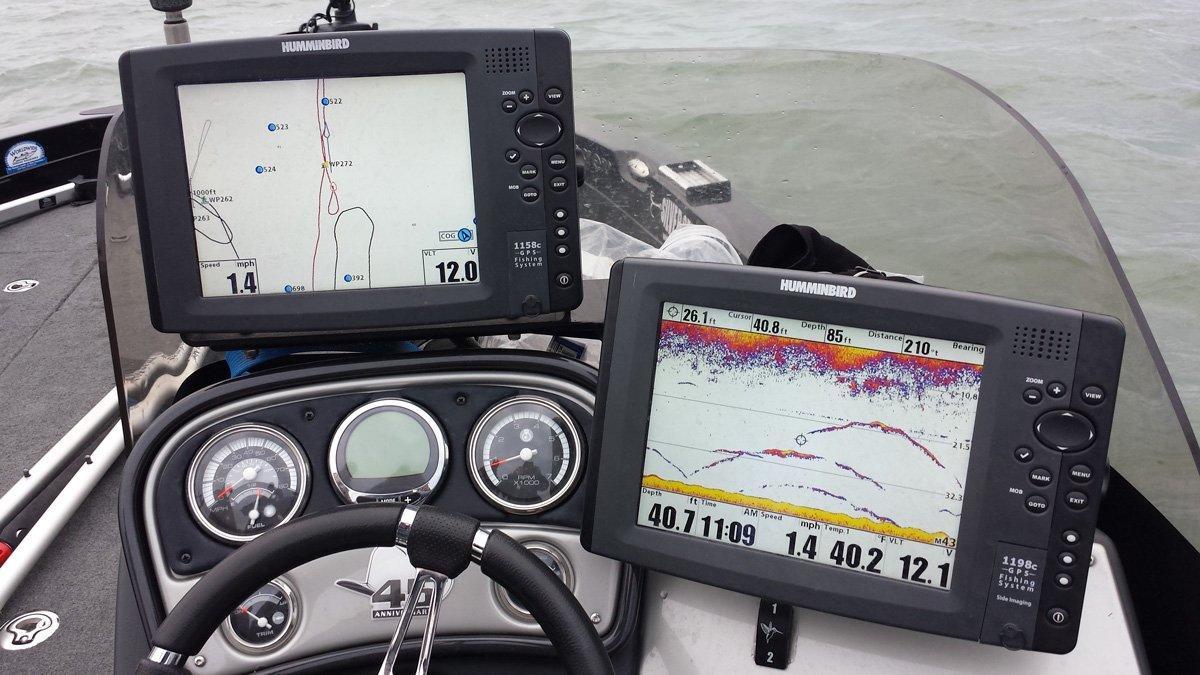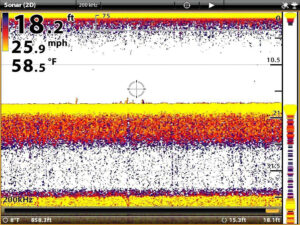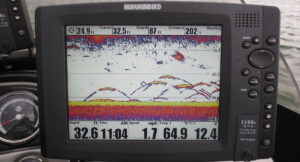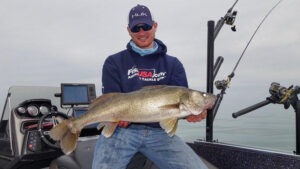The world keeps evolving and technology moves us forward. Fishing is no different. Technology such as side imaging and precision GPS positioning is long removed from milk jugs or Loran C. Knowing that you need electronics to improve your fishing is one thing, but knowing how to use them effectively and efficiently is another.
These 5 tips will help you get more walleyes this spring:
- Adjusting sensitivity
- Fish higher
- Understand bottom readings
- Search faster
- Embrace new imaging
ADJUST THE SENSITIVITY
I see a lot of screen shots posted on Facebook and even a few friends who tell me they were on the “mother lode.” Yet, they just couldn’t get any of them to bite. In many cases these aren’t catchable size walleyes but instead bait fish or other non-target species. If you turn your sensitivity up past the proper level for the conditions, you can make a minnow look like a Loch Ness monster.
This is even easier to do with today’s modern fish finders because they have many auto filters that eliminate background clutter. In the old days, if you turned your sensitivity too high, you would just black out the screen. Today’s units are made to “video game” a drop shot rig and pick up the smallest details.
The easiest way to adjust the sensitivity and also make sure your transducer is not malfunctioning is to more than double the bottom range of your bottom depth. For example, if you are in 20 feet of water make your bottom range approximately 50 feet. This will allow you to see a double echo or bottom return. Adjust your sensitivity so that you can see this second return, but not so much that it is overpowering. If you can’t see the second return even with the sensitivity near 100% you likely have a damaged transducer.
Making this adjustment will ensure that you are seeing the fish more size appropriate. This quick process will allow you to adjust your sensitivity properly when fishing new waters also. If you typically fish less than 30 feet and then fish a large basin lake in the summer that is more than 80 feet deep, you will need more power to see what is truly there.
LOW IS NO GO
Early in the year, many anglers get caught up with putting lures low in the water column if not on the bottom itself. Giant thick banana peel looking marks are appealing, but often a mistake to chase. Before any emails come in saying that you caught them on the bottom that one time with neighbor Tom, yes fish can be caught on bottom in the spring, but they are typically much more negative and getting strikes is not in your favor.
In most cases, these are either pre or post spawn females that are some of the biggest fish in the lake. The odds are in your favor instead to chase fish that are higher in the water column. They are higher because they are likely in a different phase or spawning or recovering and are higher in the warmer water chasing baitfish.
The exception to this rule is a few weeks after many of the fish have spawned and the water temps approach 50 degrees. It’s at this time that walleyes can be caught on many systems by putting a spinner rig on a bouncer or 3-way rig moved very slowly near bottom. It is not uncommon for these fish to come up with gills and cheeks literally caked with muck and bottom mud.
It is also important to remember that a transducer cone looks like an upside down ice cream cone and the size covered near the bottom is more than double what it is half way through the water column. In theory every two or three fish you see near bottom is equal to just one half way down or higher.
BOTTOM IS NOT BOTTOM
Understanding how fish mark in relation to their position in the cone is a complex topic. Most of us can’t wrap our heads around the fact that when we see fish marked on bottom that they aren’t actually on bottom. Bruce “Doctor Sonar” Samson has a slide in his electronics class that shows a tennis ball suspended 18 inches above bottom in his pool. Depending on how close the ball is directly below the transducer it will appear differently, even though we know in that controlled environment that it has not changed.
According to Samson, even the latest and greatest electronics can be difficult at best to mark fish that are glued to bottom or in-between rock crevices unless we run over them just right and maybe not even then.
Experiment with different screen color pallets to find those that make it easier to differentiate fish that are close to bottom to help detect more of these elusive bottom huggers. Often the best ways to know if walleyes are on bottom is to simply run a lure through if you suspect fish are present.
PUT THE BOAT UP
When facing clean water or when looking for walleyes on large open basins such as the Great Lakes putting the boat on plane can be the best way of locating fish. Walleyes, particularly high in the water column, tend to spook from boats overhead. Even if they didn’t, graphing at two to four miles per hour is about as efficient as cleaning your tub with a toothbrush.
Today’s units are much better programmed for high speed graphing. My Humminbird Onix auto filters so that you can see fish at twenty plus miles per hour without having a blacked out screen or fish filtered out unintentionally.
At speeds on plane from 16 to 30 mph fish will only show up as little red or yellow specks depending on your pallet colors and manufacture. Don’t expect to see an arch or large mark. At that speed walleyes are only in the cone for a brief second and it will be a small mark even if it’s a large walleye. Marks that look more like little round blobs are typically pods of baitfish.
IMAGING IS YOUR FRIEND
The advantage of side and down imaging seems to be widely known by bass anglers, but is often overlooked by walleye fisherman. This topic alone could fill an entire seminar, but for me they each offer a distinct advantage for spring walleyes.
Side imaging helps detect high walleyes or baitfish that spook out from the 2D sonar, particularly since the cone is only a few feet wide near the water’s surface. When I consistently see baitfish high in the water column on my side imaging that doesn’t appear on my 2D sonar it gives me the confidence to run lures in the top ten feet of the water column. Walleyes never go far from the grocery store!
Down imaging can also be effective for a different reason. As the water starts to warm in mid to late spring we often see large blobs on our 2D sonar. These blobs are almost always undecipherable unless you have down imaging. The picture on my Humminbird Onix down imaging is so clear, I can actually tell if it’s a pod of shiners or larger fish like crawler stealing white bass. This can be invaluable information, and you will quickly learn what these differences actually are.
Just forking out the money for a high end unit won’t catch you more fish. Taking the time to learn what it’s telling you and how to more efficiently use it will make you a much better fisherman. Buying a power cable that can be plugged into 110 and used in the house is a great way to build confidence and comfort level with your unit before you get frustrated with it on the water.

















